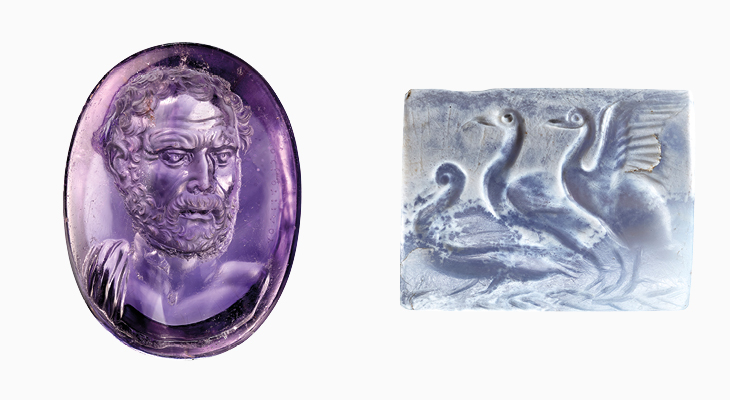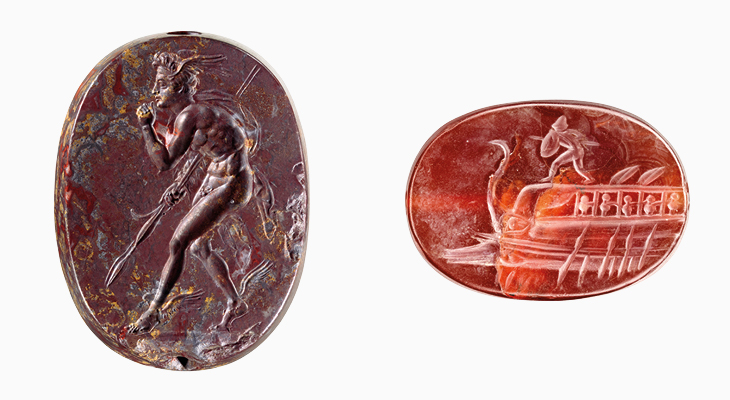Gems from the Sangiorgi Collection
J. Paul Getty Museum, Los Angeles
The recent purchase at auction of a group of 17 ancient engraved gems by the J. Paul Getty Museum has rightly been heralded as truly remarkable. The gems that have now been bought by the Getty had all been brought together through judicious and knowledgeable collecting, mainly before the Second World War, by the scholar and art dealer Giorgio Sangiorgi (1886–1965). The entire private collection has never been exhibited, and was only recently published for the first time in 2017 in Masterpieces in Miniature: Engraved Gems from Prehistory to the Present (which I co-authored with the classical art historian and archaeologist John Boardman). Only a small selection of 40 gems was offered in the New York auction at Christie’s, New York, on 29 April 2019, and the Getty managed to acquire almost half. They include two of the most famous and significant Roman gems, known and coveted by the most discerning collectors since the Renaissance, with a collection history to match.
Left: Intaglio with portrait bust of Domesthenes (c. 25 BC), signed by Dioskourides. Right: Engraved tabloid with three water birds (1600–1500 BC), Minoan, Crete

The Marlborough Antinous, the most expensive gem in the auction, realised more than $2m. Engraved on a black, slightly translucent stone, the unusually large intaglio was broken and the lower part of the bust restored in gold. The engraving shows in exquisite detail a bust of Antinous shouldering a spear. The image of the young lover of the Emperor Hadrian (r. 117–138 AD) is captivating. Antinous was a country boy who became a hero and a god with empire-wide reach. His portrait survives on statues, busts and heads, and more than 30 cities in the Greek East issued coins representing Antinous in a wide range of heroic and divine forms. Among all of them the intaglio is one of the most striking ancient portraits of Antinous to survive.
The second Roman portrait gem acquired by the Getty has a more challenging subject. It does not show a glamorous youth, but the ageing Athenian orator and statesman Demosthenes (384–322 BC), with furrowed brow, receding hairline and thin lips. It is a copy of a famous bronze statue commissioned after his death by Demosthenes’ nephew and set up in the Agora, in Athens. It is signed in Greek by Dioskourides, who was, according to Pliny the Elder, the engraver of the Emperor Augustus’s personal seal. The face is engraved in three-quarter view and so deeply cut that it is almost a statuette in the round. The material is particularly striking: a translucent amethyst in a dark shade of purple allows the viewer not only to appreciate the surface of the stone, but also to see the sides of the head when the stone is turned.
Left: Engraved scaraboid with Perseus (400–350 BC), Greece. Right: Engraved scaraboid with Protesilaos on the prow of a ship (400–350 BC), Greece

Other gems now in the Getty are lesser-known but of equal technical skill and significance. The Greek scaraboid from the 4th century BC showing the hero Perseus standing on tip-toe is a masterful study of the male human figure, and surely one of the best gems of the period.
The new acquisition complements the Getty’s existing holdings beautifully. The group will form part of a special exhibition opening at the Getty Center in December and will then go on view at the Getty Villa.
Claudia Wagner is the co-author with John Boardman of Masterpieces in Miniature: Engraved Gems from Prehistory to the Present (Philip Wilson Publishing in association with the Beazley Archive).
The Winners | Personality of the Year | Artist of the Year | Museum Opening of the Year | Exhibition of the Year | Book of the Year | Digital Innovation of the Year | Acquisition of the Year | View the shortlists



